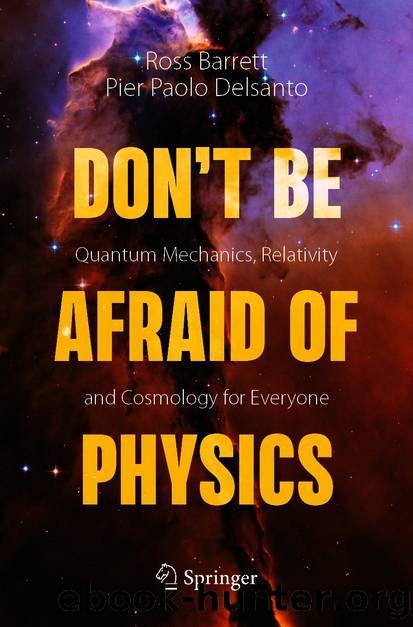Donât Be Afraid of Physics by Ross Barrett & Pier Paolo Delsanto

Author:Ross Barrett & Pier Paolo Delsanto
Language: eng
Format: epub
ISBN: 9783030634094
Publisher: Springer International Publishing
8.2 Particles
In Chap. 5, we have seen how the idea that matter in the universe is composed of elementary particles, called atoms, has been around at least since the time of the early Greeks. By the start of the 20th Century, it was recognised that electromagnetic radiation also exhibits corpuscular properties in some circumstances. Any doubt about the atomic structure of matterâand there had been many doubters because of the difficulty of observing atomsâhad been dispelled by Einsteinâs paper in 1905 explaining Brownian motion (see Chap. 5).
The 19th Century had also seen the discovery of the electron, the fundamental particle of electricity. In 1897, the British physicist J. J. Thompson reported in The Philosophical Magazine experiments on the strange cathode rays emitted from a heated metal in a vacuum. His ingeniously designed experiments used deflections of the cathode rays by electric and magnetic fields to verify that the rays were indeed comprised of electrified particles, now known as electrons, and went on to determine the ratio of the electric charge of the particles to their mass.
A number of other rays were also discovered towards the end of the 19th Century. These were X-rays, produced by Wilhelm Röntgen in 1895, and the alpha, beta and gamma rays emitted during the radioactive decay of uranium, and discovered in 1899 and 1900 by Henri Becquerel, Paul Villard and Ernest Rutherford, working independently. Further experiments to determine the electric charge-to-mass ratio of the alpha and beta particles found that the positively charged alpha particle was most probably a helium atom with its two electrons stripped away, and the negatively charged beta particles were electrons. Gamma rays were a very energetic form of electromagnetic radiation. Both X-rays and gamma rays, and also visible light, heat rays (infra-red radiation) and chemical rays (ultra-violet radiation), are now known to be made of photons of different frequency (see Fig. 5.â1).
So at the end of the 19th Century there was a widespread belief that apart from a few wayward examples (electrons, and the particles emitted in radioactive decay), the fundamental building blocks of matter are atoms. Such a belief did not survive for very long. Indulging in a pursuit that is fairly common among curious children, physicists began smashing objects together to see what lay inside.
Ernest Rutherford, together with Hans Geiger and Ernest Marsden, bombarded gold atoms in a thin foil with alpha particles, and observed that a significant number of these positively charged alpha particles were deflected at large angles, some even travelling back towards their source. Rutherford attributed the deflection to electrostatic repulsion. However, the gold atom is electrically neutral, so large deflections were not to be expected. A detailed mathematical analysis showed that the observed deflections (called scattering) could be explained if the gold atom had a small, positively charged nucleus at its core, surrounded by a diffuse cloud of negative charges (presumably electrons), to maintain its electrical neutrality. The scattering is illustrated in Fig. 8.1. This picture of the atom became known as the Rutherford Model.
Download
This site does not store any files on its server. We only index and link to content provided by other sites. Please contact the content providers to delete copyright contents if any and email us, we'll remove relevant links or contents immediately.
What's Done in Darkness by Kayla Perrin(25493)
Shot Through the Heart: DI Grace Fisher 2 by Isabelle Grey(18209)
Shot Through the Heart by Mercy Celeste(18153)
The Fifty Shades Trilogy & Grey by E L James(17768)
The 3rd Cycle of the Betrayed Series Collection: Extremely Controversial Historical Thrillers (Betrayed Series Boxed set) by McCray Carolyn(13182)
The Subtle Art of Not Giving a F*ck by Mark Manson(12898)
Scorched Earth by Nick Kyme(11823)
Stepbrother Stories 2 - 21 Taboo Story Collection (Brother Sister Stepbrother Stepsister Taboo Pseudo Incest Family Virgin Creampie Pregnant Forced Pregnancy Breeding) by Roxi Harding(11019)
Drei Generationen auf dem Jakobsweg by Stein Pia(10211)
Suna by Ziefle Pia(10179)
Scythe by Neal Shusterman(9251)
International Relations from the Global South; Worlds of Difference; First Edition by Arlene B. Tickner & Karen Smith(8600)
Successful Proposal Strategies for Small Businesses: Using Knowledge Management ot Win Govenment, Private Sector, and International Contracts 3rd Edition by Robert Frey(8407)
This is Going to Hurt by Adam Kay(7682)
Dirty Filthy Fix: A Fixed Trilogy Novella by Laurelin Paige(6445)
He Loves Me...KNOT by RC Boldt(5798)
How to Make Love to a Negro Without Getting Tired by Dany LaFerrière(5369)
Interdimensional Brothel by F4U(5299)
Thankful For Her by Alexa Riley(5149)
